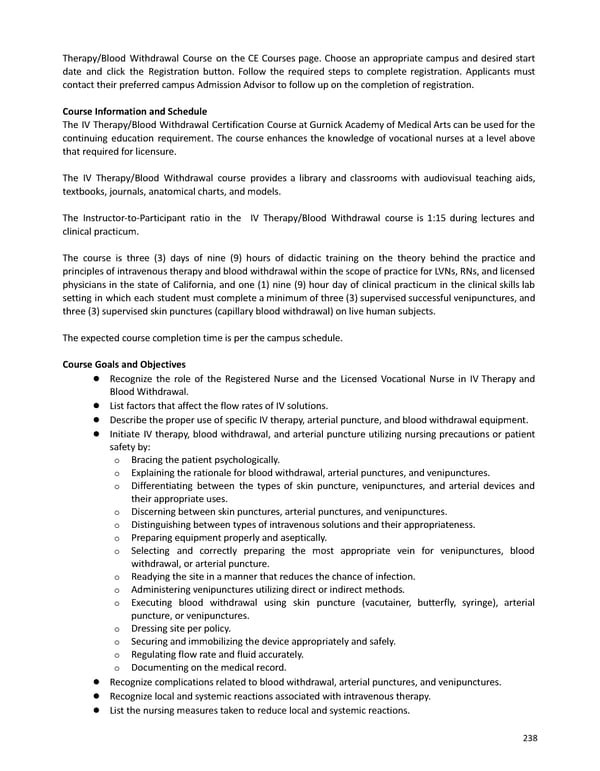Therapy/Blood Withdrawal Course on the CE Courses page. Choose an appropriate campus and desired start date and click the Registration button. Follow the required steps to complete registration. Applicants must contact their preferred campus Admission Advisor to follow up on the completion of registration. CourseInformationandSchedule The IV Therapy/Blood Withdrawal Certification Course at Gurnick Academy of Medical Arts can be used for the continuing education requirement. The course enhances the knowledge of vocational nurses at a level above that required for licensure. The IV Therapy/Blood Withdrawal course provides a library and classrooms with audiovisual teaching aids, textbooks, journals, anatomical charts, and models. The Instructor-to-Participant ratio in the IV Therapy/Blood Withdrawal course is 1:15 during lectures and clinical practicum. The course is three (3) days of nine (9) hours of didactic training on the theory behind the practice and principles of intravenous therapy and blood withdrawal within the scope of practice for LVNs, RNs, and licensed physicians in the state of California, and one (1) nine (9) hour day of clinical practicum in the clinical skills lab setting in which each student must complete a minimum of three (3) supervised successful venipunctures, and three (3) supervised skin punctures (capillary blood withdrawal) on live human subjects. Theexpectedcoursecompletiontimeisperthecampusschedule. CourseGoalsandObjectives ● Recognize the role of the Registered Nurse and the Licensed Vocational Nurse in IV Therapy and BloodWithdrawal. ● ListfactorsthataffecttheflowratesofIVsolutions. ● DescribetheproperuseofspecificIVtherapy,arterialpuncture,andbloodwithdrawalequipment. ● Initiate IV therapy, blood withdrawal, and arterial puncture utilizing nursing precautions or patient safety by: o Bracingthepatientpsychologically. o Explainingtherationaleforbloodwithdrawal,arterialpunctures,andvenipunctures. o Differentiating between the types of skin puncture, venipunctures, and arterial devices and their appropriate uses. o Discerningbetweenskinpunctures,arterialpunctures,andvenipunctures. o Distinguishingbetweentypesofintravenoussolutionsandtheirappropriateness. o Preparingequipmentproperlyandaseptically. o Selecting and correctly preparing the most appropriate vein for venipunctures, blood withdrawal, or arterial puncture. o Readyingthesiteinamannerthatreducesthechanceofinfection. o Administeringvenipuncturesutilizing direct or indirect methods. o Executing blood withdrawal using skin puncture (vacutainer, butterfly, syringe), arterial puncture, or venipunctures. o Dressingsiteperpolicy. o Securingandimmobilizingthedeviceappropriatelyandsafely. o Regulatingflowrateandfluidaccurately. o Documentingonthemedicalrecord. ● Recognizecomplicationsrelatedtobloodwithdrawal,arterialpunctures,andvenipunctures. ● Recognizelocalandsystemicreactionsassociatedwithintravenoustherapy. ● Listthenursingmeasurestakentoreducelocalandsystemicreactions. 238
 2023-2024 | Catalog Page 237 Page 239
2023-2024 | Catalog Page 237 Page 239